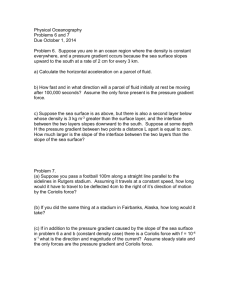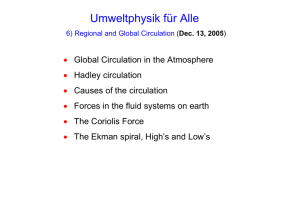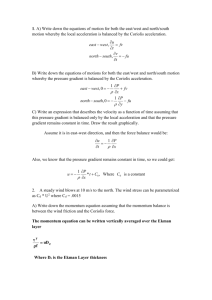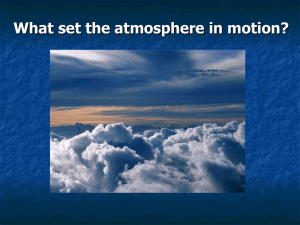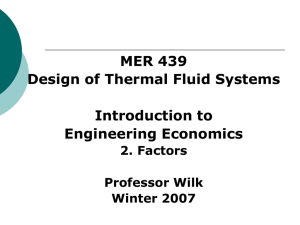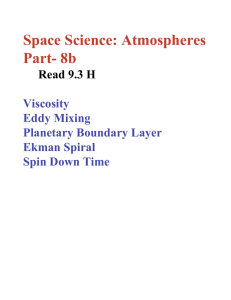Folie 1
advertisement
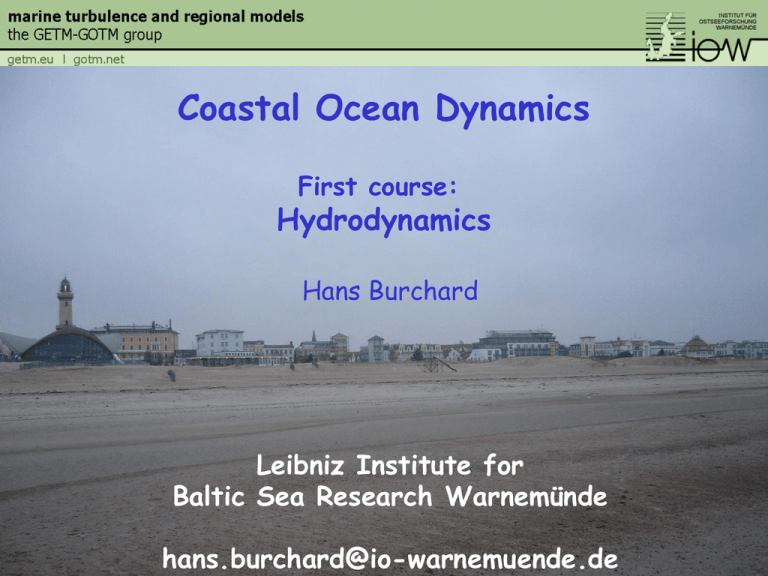
Coastal Ocean Dynamics First course: Hydrodynamics Hans Burchard Leibniz Institute for Baltic Sea Research Warnemünde hans.burchard@io-warnemuende.de What makes it move? Some principle laws of mechanics and thermodynamics. Various conservation laws are defined on a material volume of a homogeneous substance such as water or air, moving with the flow. Conservation of mass Within a material body, mass is conserved, i.e., the number of molecules and their mass remain the same. Conservation of momentum Momentum: density X velocity Newton‘s Second Law: Within a material body, the change of momentum is equal to sum of the forces acting on the body F may be due to a body force (typically gravitational force) or due to a force on the surface of the body. Conservation of angular momentum Within a material body, the change of total angular momentum M is equal to sum of the torque of the forces acting on the body. Actio = Reactio Newton‘s Third Law: If a body A excerts a force on a second body B, then B excerts the same force on A but with the different sign. Law of gravitation The body B1 has mass m1, and a second body, B2 has mass m2, and they have the distance r along the unit vector, n, connecting the two. Then, the gravity force, G, between the two bodies given by where g is the universal constant of gravity. First law of thermodynamics Balance of energy The change of total energy of a material body is equal to the rate of work done by the mechanical forces acting on the body (PV) and its surface (PA), the internal heat supply (R) and the total heat flux Q through the boundary: 4 ways to increase the energy of an apple … Second law of thermodynamics Entropy* cannot decrease except for external forcing. This means for example … … Heat always flows from high to low temperature. … Mechanical energy can be converted into heat via friction, but not the other way around. *Measure for disorder Material laws Fluids like water or air are called Newtonian because the viscous stresses that arise from its flow, are proportional to the local shear rate. Incompressibility constraint In contrast to air, water is relatively incompressible. This has the consequence that horizontally converging water transports lead to an increasing sea level. Hydrostatic assumption If all flow is at rest, the pressure p is in hydrostatic equilibrium, i.e. the vertical pressure gradient is proportional to the density of the water (gravitational acceleration g is the constant of proportionality): In ocean models we assume that the pressure is hydrostatic also when the flow is not at rest. Dynamic shallow water equations Finally, the dynamic equations are of the following form: acceleration advection rotation pressure gradient friction x,y,z: westward, northward and upward coordinate (m/s) u,v,w: westward, northward and upward velocity component (m/s) t: time (s) p: pressure (N/m2=kg/(s2m) f: Coriolis parameter (2w sin(f), f latitude, w Earth rotation rate) g: gravitational acceleration (=9.81 m/s2) r0: reference density Fx,Fy: friction terms Decomposition of pressure gradient The pressure gradient can be decomposed to three contributions: pressure gradient = surface slope + density gradient atmospheric + pressure gradient Equation of state Density r of seawater is a nonlinear function of temperature , salinity S, pressure p: maximum density temperature freezing temperature Let us now study idealised situations where two terms in the dynamic equations balance and the others are zero. Channel flow Balance between pressure gradient and friction*. Solution for constant eddy viscosity: Solution for parabolic eddy viscosity: *We need to make here a little excursion into the definition of eddy viscosity Channel flow Inertial oscillations Balance between rate of change and Coriolis rotation: Inertial oscillation (observations in the Western Baltic Sea) Van der Lee and Umlauf (2011) Geostrophic equilibrium Balance between pressure gradient and Coriolis rotation: Flow is 90° to the right of the pressure gradient. Geostrophic equilibrium Air flow around a low-pressure area is anti-clockwise in the Northern hemisphere, and clockwise in the Southern hemishere (=cyclonic). Ekman dynamics Balance between Coriolis rotation and friction: Vertically integrated transport (U,V) is 90° to the right of the wind stress (in Northern hemispere). This is also called the Ekman transport. Ekman dynamics Ekman spiral for constant eddy viscosity: Kundu and Cohen (2002) Ekman depth: Upwelling If there is a coast to the left (Northern hemisphere) of the current, then the Ekman transport is compensated by upwelling water from depth: Downwelling results from a coast to the right of the wind. Kelvin waves Kelvin waves are long propagating waves which lean on a coast to the right (Northern hemisphere): Gill (1982)
